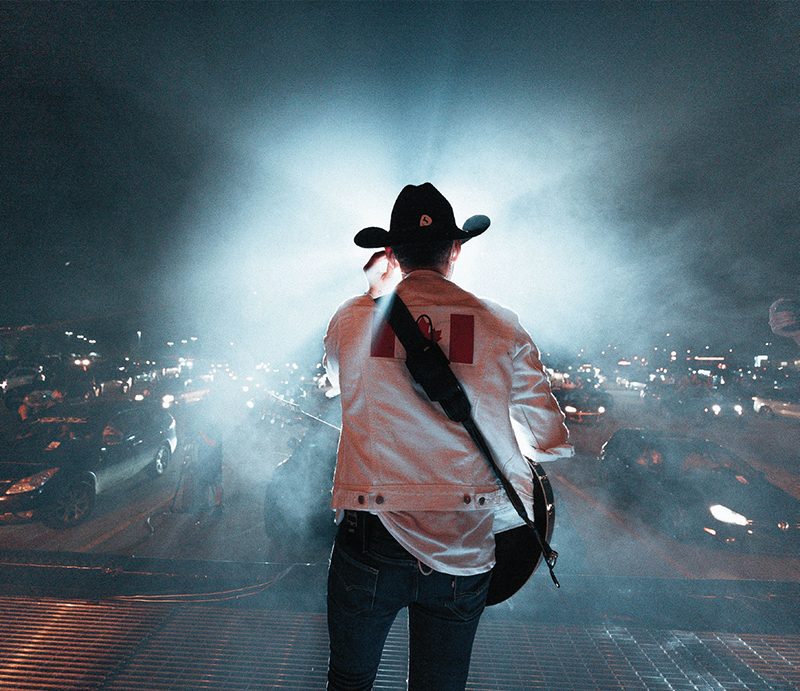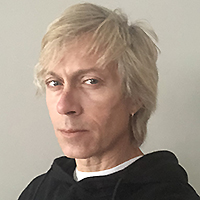It’s a fair bet that celebrated Canadian country artist Brett Kissel has never said to a crowd, “I want to see your arms waving out the windows.” But in our current pandemic times, that’s exactly what he did during a series of Western Canada drive-in shows earlier this summer. And, as artists and audiences cope with the “new normal” and drive-in concerts become more common, so will that unique variety of onstage patter.
By the time you read this far more drive-in shows will have taken place globally, but Kissel’s series of concerts was one the earliest, and the first major outing of its kind in Canada. On June 13 and 14, he and his band performed eight shows in the parking lot of River Cree Resort and Casino near Edmonton, Alberta; two with tickets provided gratis to first responders and frontline workers, and six for the general public, with all proceeds going to Food Banks Alberta through the Safeway Community Action Fund.
The first show that was announced sold out in five minutes. In addition to Edmonton, Kissel and company used the same production package for similar shows later that month; three in Regina and three in Saskatoon, Saskatchewan.
While some may view drive-in concerts skeptically – as a pale imitation of the “typical” live experience – the challenges of the moment have made it necessary for artists, production houses and audiences to adjust their expectations. As the banners around the River Cree show site said, “Tough Times Don’t Last, Tough People Do.”

Under The Gun
The drive-in format was an eventuality Soundbox Productions has been preparing for since the pandemic was first declared, says Colin Moore, manager of special projects for the Hamilton, Ontario-based AV firm. “After Brett reached out and said, ‘We’re doing it,’ we had about a month to put it together,” Moore notes. “Even so, we felt a bit under the gun because, from the audio side to the big picture, it was new territory for everyone involved.”
That said, he adds: “It’s really motivating to see companies and artists rethinking the way they do things to remain productive, and we couldn’t have worked with a better artist. “I’ve worked as Brett’s lighting/video director for some time, and Soundbox had been providing production for Kissel for years.”
From an audio perspective there were challenges, but the major concern was safety, which impacted pretty much everything from the moment the show was a go; even while packaging and testing the production package in the Soundbox warehouse. The process required audio and lighting/video crews to trade off time in the shop.
At River Cree, additional measures included capping attendance for each show at approximately 180 vehicles, requiring audience members to stay in their cars, and separating the musicians using plexiglass shields, which were in place for rehearsals in the Casino’s event space as well as on stage during performances.

“That was required by Alberta health services for everyone singing, except Brett,” says monitor engineer James Bundy. “And everyone sings except our drummer, Spencer Cheyne, but we ended up putting one in front of him as well because with the open sides of everyone’s shields facing the drums we’d essentially created a bunch of telephone booths the drums were playing into.”
For the Saskatchewan shows, loaders and stagehands were brought in. In Edmonton, however, the eight touring crew members did everything. “We had to keep it lean because we couldn’t have more than fifty staff on site; including parking, the band, security – the full kit and caboodle,” Moore says. “We made the decision to do everything ourselves to keep the potential impact down. One of our biggest fears was – whether it was local crew or someone else who attended the show – coming out weeks later and saying, ‘I went out to that concert in Edmonton and caught COVID-19’.”
It was about sending the right message, he continues: “I really didn’t need to be wearing a mask at front of house running lights because we were all more than six feet apart, but we wanted to set an example and for people attending the shows to feel comfortable.”
Step By Step
After a Zoom call with Kissel, Bundy and front of house engineer Joel Bird, Moore and Jamal Bleasdell, who heads up the Soundbox audio department, began putting the systems together. Moore: “Jamal and I did a lot of research. We talked to people who mix live, in studios, and for radio to make sure the show would sound great and that we were limiting it in the correct way so we weren’t taking away too much, but also weren’t causing issues with the FM broadcast.”
The first step was putting an Avalon 747 in line before the FM transmitter. “We pulled the Avalon in, just to help us with the tonality and to warm up the signal,” he explains. “Next, because the frequency range and how FM processes audio is different than a full-range PA, we decided to use a Lake LM 44 [processor]. The A/D converters in them are phenomenal and we could also do a lot of tone shaping and adjustments in it to make sure everything sounded great. But we used the LM 44 primarily as a limiter, which allowed us to avoid pushing into the danger zone.”

Additionally, Moore notes: “We were able to do a point-to-point hotspot with the LM 44, so our system tech sat in a car listening to the feed and adjusted the limiter and the EQ with a tablet. Then we took a multi-tracked recording from rehearsal, just a snippet, and broadcast that so everyone – our guys, Brett, the band, whoever was interested – could listen and provide feedback.”















